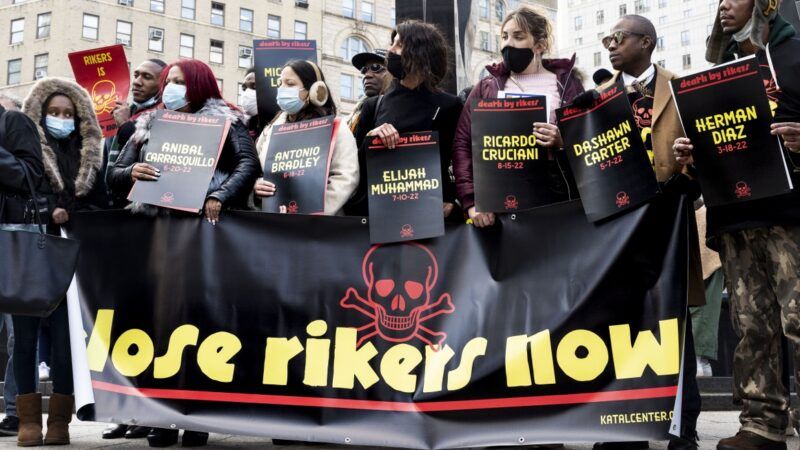Rikers Island Sees 19th Death This Year After Judge Gives Leaders More Time To Fix Its Messes
Somehow deaths have climbed even though the prison population has dropped.

Rikers Island has logged its 19th prisoner death in 2022 as the end of the year approaches, but a judge is still resisting efforts to turn the jail complex over to federal control.
Edgardo Mejias, 39, was found unresponsive in his cell on December 11 and subsequently declared dead of a suspected drug overdose. The New York Daily News reported that Mejias was arrested (as was his girlfriend) in September for shoplifting perfume. His bail had been set for $10,000. He also had a recent history of shoplifting charges and failing to show up for court dates.
Mejias' lawyer, Dean Vigliano, told the New York Daily News that Mejias had been complaining that he hadn't been getting proper treatment for his asthma and had been having trouble breathing. Rikers has chronic problems with getting its inmates proper medical treatment and causing them to miss appointments and has been fined $200,000 for it.
According to the most recent data from the New York City comptroller's office, Rikers improved its record in getting prisoners treated in early 2022, but it has been getting worse again. Just in October, the prison complex (which holds about 5,800 prisoners daily) logged close to 10,000 missed medical appointments for various reasons.
The Legal Aid Society in New York City had requested that federal Judge Laura Taylor Swain of the U.S. District Court of the Southern District of New York let them push for federal receivership of Rikers because of the many, many problems that have been plaguing the prison for years. During the pandemic, the prison saw massive shortages of 15 percent to 20 percent of the staff. Even though those numbers have improved, the comptroller's office notes that they're still missing about 12 percent of staff on a daily basis.
Also, keep in mind that Rikers' population has been declining since 2008 even as the number of deaths per year has increased. The complex holds less than half the number of prisoners as it did then, yet it has seen the most deaths in a year since 2013 (when 24 prisoners died).
Nevertheless, Swain in November turned away the push to give the feds control over Rikers. The prison complex is already under federal monitoring, and the independent team is regularly putting out reports of conditions there. In October, the team put out its second report since the court ordered the New York Department of Correction to develop a formal plan to get its act together. The 286-page report doesn't start off with much encouraging news:
Problematic practices include poor supervision and inadequate support for staff on the housing units, poorly executed physical restraints, a lackadaisical approach to basic security measures like securing doors and dispersing crowds, and a general lack of situational awareness. Staff's often hyper-confrontational demeanor contributes to incidents spiraling out of control, and the overreliance on Emergency Response Teams and the response by an overabundance of staff means that force is often precipitated and/or exacerbated by staff's own behavior. In addition, the disordered environment and staffing problems discussed in the "Staffing" section of this report result in the constant disruption of even the most basic services (e.g., recreation, laundry, commissary, barbershop), which creates additional frustration among the people in custody, who are already stressed by the level of facility violence, separation from their loved ones, and uncertainty in their court proceedings to name a few.
The report notes, in bold, "At its core, successful reform will require an all-encompassing cultural and behavioral change among thousands of staff for whom poor practice has been embedded and normalized for decades." That's not a good sign.
But in the four months since the action plan has been put in place, the report notes that there have been significant changes in the leadership of the prison. There are 28 new department leaders, and according to the monitoring team, "the new leadership team has been able to enter the system, begin to analyze problems and conceptualize solutions that have at their core the connection to correctional best practice that the monitoring team has been harping about for years."
And so, on that basis, Swain decided to give Rikers' leaders more time to actually attempt to change its resistant culture before putting the feds in charge.
Former New York City Mayor Bill de Blasio agreed in 2019 to a deal that would close Rikers by 2026 and open four new jails elsewhere in the city for a cost of $8.7 billion. A year later, city officials delayed Rikers' closing until 2027. But in September of this year, Mayor Eric Adams (who also supports closing Rikers) said he doubted they'd meet the 2027 deadline.
Last week, Department of Correction Commissioner Louis Molina warned New York's City Council that officials are estimating that the population of Rikers is set to grow again and may be back up to 7,000 prisoners in two years. This could wreck the city's plans to close Rikers because as part of the closure plan, the city needs to get the complex's population to less than 3,300.
Adams may say he wants Rikers to close, but he also wants police to get people off the streets that cause problems, even ordering the involuntary institutionalization of mentally ill people. The comptroller's dashboard shows that the number of people at Rikers with a "serious mental illness" has been steadily increasing throughout 2022 and stood at an average of 1,075 per day in October. That's about 18 percent of the total number of prisoners. It's hard to see how New York City can close Rikers if they're going to try to lock up more people in there.



Show Comments (25)